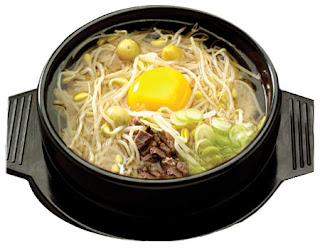Korean traditional food is one of the most unique cuisines in Asia. Basically, traditionalKorean food is based on the Royal Court Cuisine of Korea (수라상, 水 剌 床,Surasang), which are traditionally consumed in the palace from 1392 to 1910 in Korea.
Usually a few seasonings and ingredients commonly used in Korean cuisine like sesame seeds, galic, ginger, green onion, sesame oil, Doenjang (된장, fermented bean paste), Gochujang (고추장, 苦 椒 酱), etc.
Korean food is known as healthy food ingredients because it emphasizes nutritional balance as mentioned in the order of the food pyramid. Like other Asian countries, riceis the staple food in Korean cuisine. In addition, Korea also consume noodles, various vegetables, meat and tofu.
A variety of food dishes can be found in the entire country of Korea. Korea is an agricultural country, and Korea have been cultivating rice as their staple food since ancient times
Today's Korean cuisine is characterized by a variety of dishes of meat and fish mixed with vegetables, fermented and preserved foods, like kimchi (fermented spicycabbage), jeotgal (matured seafood with salt) and doenjang (fermented soybean paste) is famous for its taste specific and high nutritional value.
Unique way of eating from Korea is that all meals served at the same time.Traditionally, the number of side dishes varied from 3 to lower-class types to 12 types for members of the royal family. Arrangements can vary depending on whether the noodle dish or meat is served. Formal rules have been developed to set the table.Compared to neighboring China and Japan, a spoon is used more often in Korea,especially for the dish soup.
BAP (White rice) / JUK (Porridge)
Porridge become one of the staple food in Korea. Most people use sticky rice, which sometimes has beans, chestnuts, sorghum, red beans, barley or other cereals added for flavor and nutrition. JUK considered very nutritious. Many varieties JUK for example, JUK made from rice, red beans, pumpkin, abalone, ginseng, pine nuts, vegetables, chicken, mushrooms and bean sprouts.
GUK/SOUP
Soup is an important dish when rice is served. Material from the soup a bit different including vegetables, meat, fish, shellfish, seaweed, and beef bones ..
Jjigae (Spicy Soup)
Jjigae similar to guk but is thicker and harder. The best known of jjigae is made from fermented soybean paste. Jjigae usually spicy and served using hot stone bowl.
Dubu Jeongol (Casserole)
Cooked in a steaming pot and contains noodles, mushrooms, small octopus, beefintestines, vegetables, and other materials. The dubu (tofu), sliced, coated with starchand pan-fried. beef flavor is then inserted into the dubu and already tied up withwatercress. In a skillet casserole, vegetables and dubu prepared and boiled with soy sauce flavor the broth.
Jjim & Jorim (Meat / Fish Boil)
Jjim and Jorim is similar dishes prepared with vegetables and beans marinated in soy sauce, then slowly boiled together over low heat.
Namul (Vegetables / Wild Green)
Namul prepared by using boiled or fried green vegetable material mixed with a little salt, soy sauce, sesame salt, sesame oil, garlic, onions, and other spices.
Jeotgal (Salty Seafood)
Jeotgal is a very salty food made of naturally fermented fish, shellfish, shrimp, oysters, fish eggs, intestines and other ingredients.
Gui (Grilled Meat)
When cooking, the meat marinated and then grilled over charcoal fire. The most popular meats of this type Bulgogi and galbi. There are also fish dishes are cooked in this way.
Jeon(Pancake)
Jeon is a kind of pancake made from mushrooms, pumpkin, slices of dried fish, oysters, raw red peppers, meat or other ingredients which are mixed with salt and black pepper, dipped in flour and egg and fried in oil.
Mandu (Wonton)
Mandu are dumplings filled with beef, mushrooms, stir fried zucchini, and green bean sprouts. Pork, chicken, or fish is sometimes used as a substitute for beef.
Bulgogi
Bulgogi is the main meat food among Koreans. It is also one of the grilled beef dishes are most popular in Korea. It is made from prime beef cattle and usually marinated with a mixture of soy sauce, sesame oil, pear juice, balce pepper, garlic, red onion, scallions, wine, salt and sugar to 2 to 4 hours to enhance flavor and tenderness.
Kimchee
Kimchee is the most famous dish of Korea, or even strangers. This is a must-eat dish is served at every Korean. Kimchee many called a traditional Korean fermented vegetable. At the beginning, kimchee prepared for the winter because they can not grow crops during the winter. Therefore, they are preserved to consume vegetables in winter.
Beebimbap
Other Beebimbap popular rice-based traditional Korean food. Koreans eat this dish at the Lunar New Year Calendar as their tradition. Beebimbap literally means "mixed rice" which consists of plain rice topped with meat, vegetables, eggs, and Gochujang (고추장, 苦 椒 酱). Usually Gochujang will be served separately to control the spicy dishes.
Kimbap
Kimbap popular snack food in Korea. It is found in the street in Korea and sell it kiosks along the road. Kimbap looks like very similar to Japanese sushi, therefore, Kimbap also known as the Korean sushi. This popular snack is very variable because of variable ingredients in it such as Bulgogi, spinach, pickled radish and eggs.
Samgyetang
Samgyetang (삼계탕, 参 鸡汤) or Ginseng Chicken Soup is called in English, it is a soup-based dish. Traditional, is provided during the summer because of the healthy nutrients that can improve us during the summer where we can easily lose energy through excessive perspiration.
Naeng Myeon
Naengmyeon literally means "cold noodles" and this summer favourite is really refreshing. Traditionally a thin Traditional chewy and thin buckwheat noodles in soup served cold with chopped spring onion, radish and cucumber slices, sesame seeds, boiled egg-filled, pear and slices of lean beef, pork or chicken. There are usually hot mustard and vinegar will be presented separately to add to the noodles.
















No comments:
Post a Comment